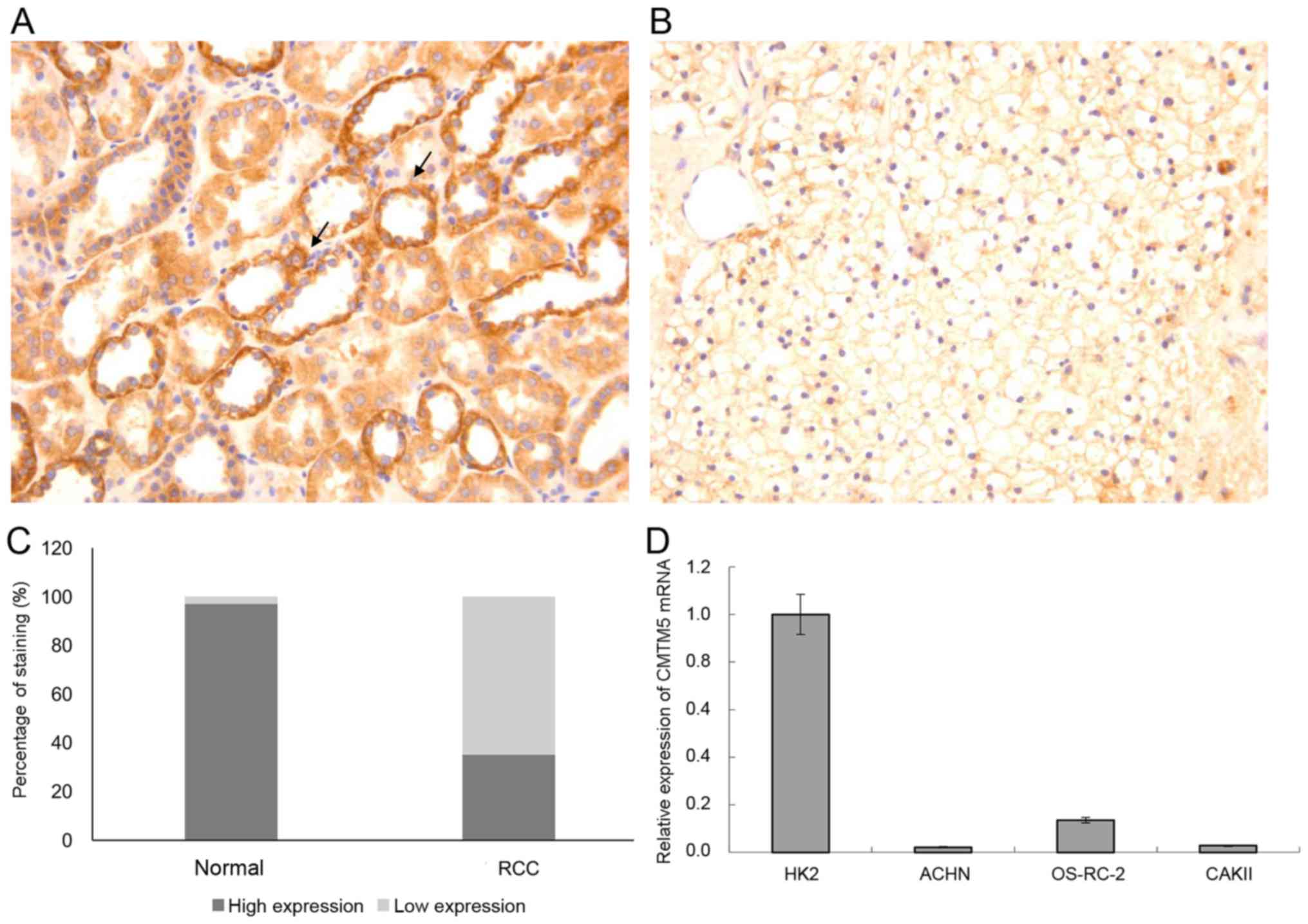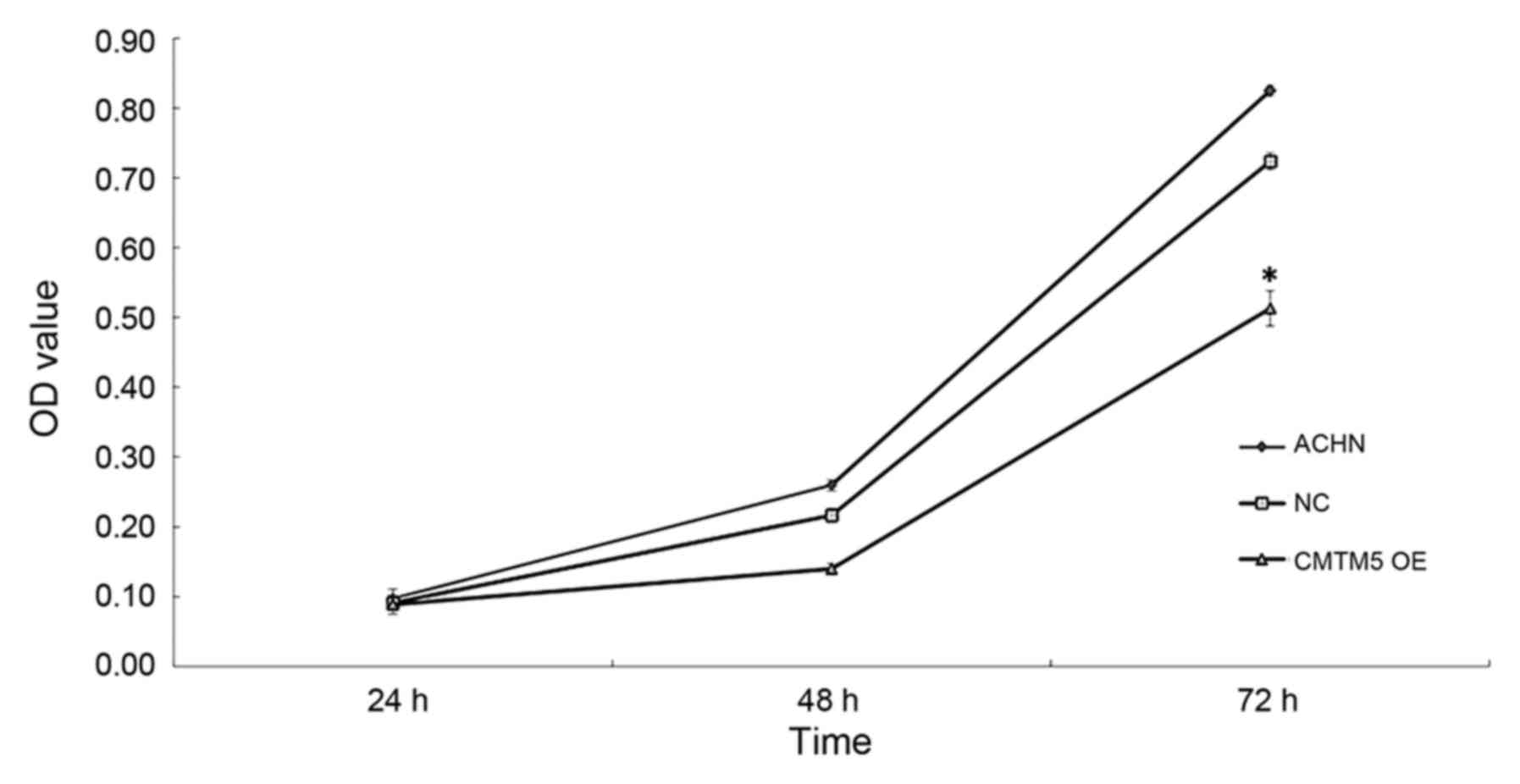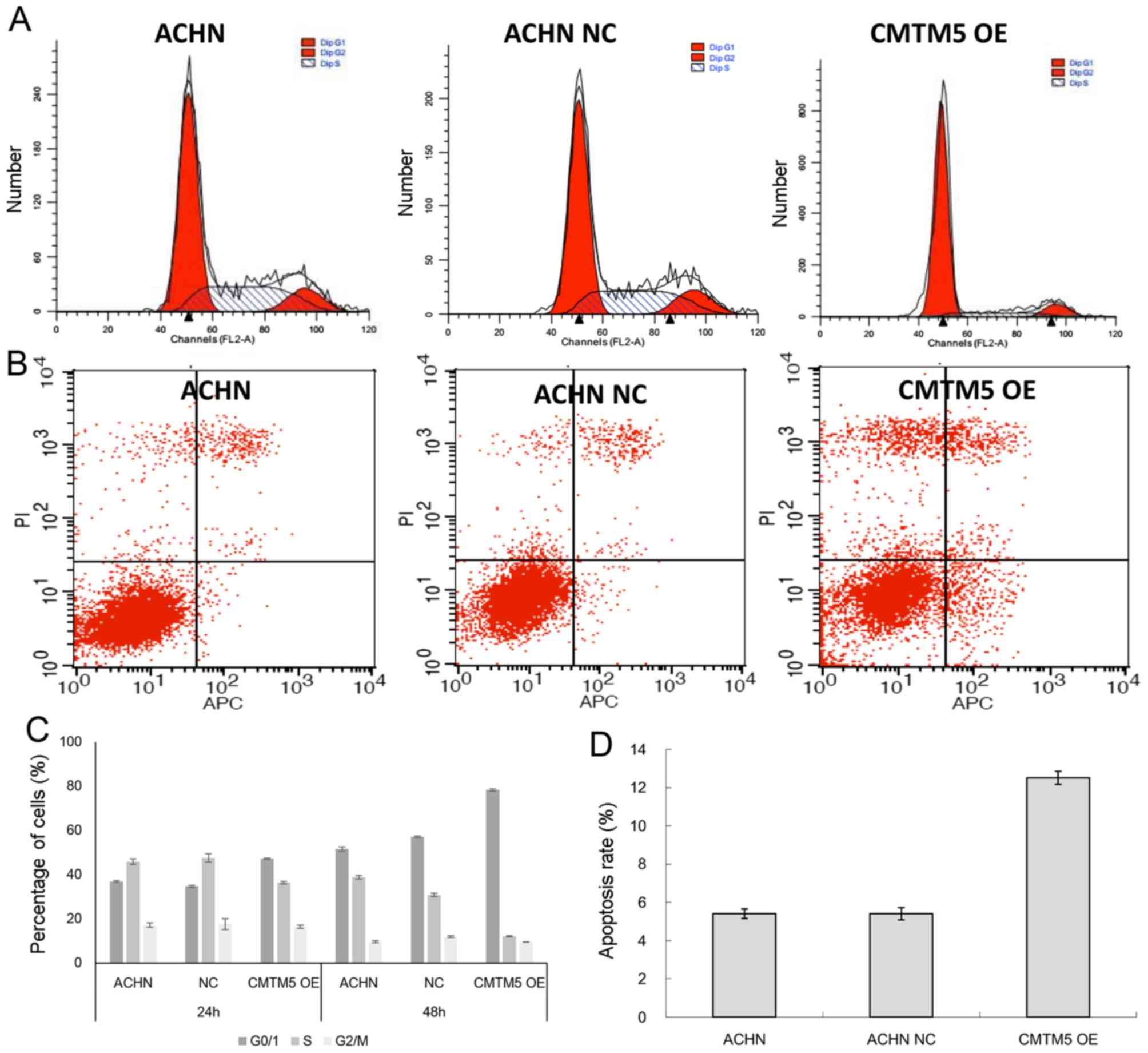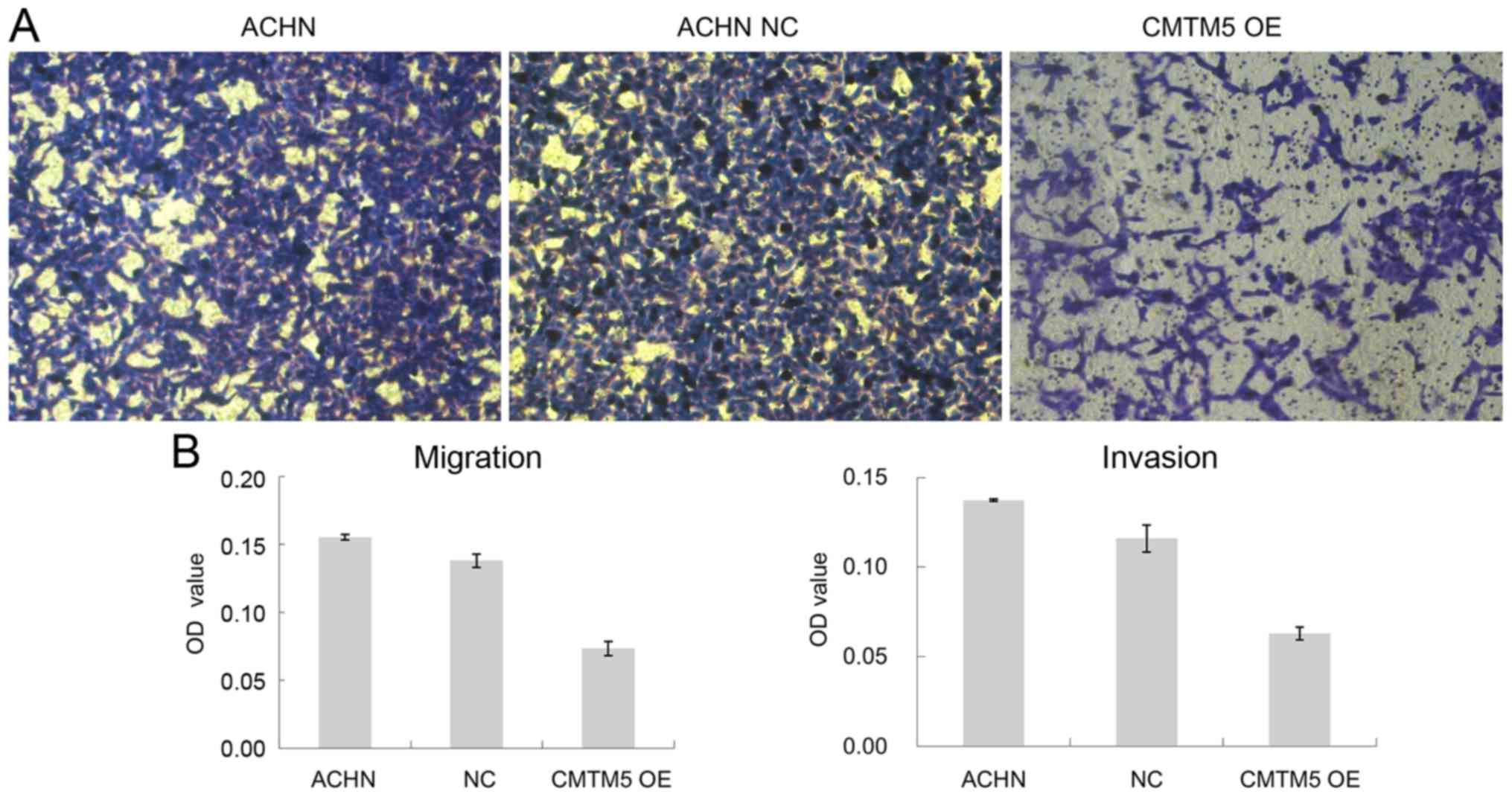|
1
|
Siegel R, Ma J, Zou Z and Jemal A: Cancer
statistics, 2014. CA Cancer J Clin. 64:9–29. 2014. View Article : Google Scholar : PubMed/NCBI
|
|
2
|
Brodaczewska KK, Szczylik C, Fiedorowicz
M, Porta C and Czarnecka AM: Choosing the right cell line for renal
cell cancer research. Mol Cancer. 15:832016. View Article : Google Scholar : PubMed/NCBI
|
|
3
|
Leibovich BC, Lohse CM, Crispen PL,
Boorjian SA, Thompson RH, Blute ML and Cheville JC: Histological
subtype is an independent predictor of outcome for patients with
renal cell carcinoma. J Urol. 183:1309–1315. 2010. View Article : Google Scholar : PubMed/NCBI
|
|
4
|
Grimm MO, Wolff I, Zastrow S, Frohner M
and Wirth M: Advances in renal cell carcinoma treatment. Ther Adv
Urol. 2:11–17. 2010. View Article : Google Scholar : PubMed/NCBI
|
|
5
|
Xiao W, Wang J, Li H, Guan W, Xia D, Yu G,
Xiao H, Lang B, Ma X, Liu J, et al: Fibulin-1 is down-regulated
through promoter hypermethylation and suppresses renal cell
carcinoma progression. J Urol. 190:291–301. 2013. View Article : Google Scholar : PubMed/NCBI
|
|
6
|
Guo X, Li T, Wang Y, Shao L, Zhang Y, Ma D
and Han W: CMTM5 induces apoptosis of pancreatic cancer cells and
has synergistic effects with TNF-alpha. Biochem Biophys Res Commun.
387:139–142. 2009. View Article : Google Scholar : PubMed/NCBI
|
|
7
|
Li P, Liu K, Li L, Yang M, Gao W, Feng J,
Lv Y, Qu X and Kong B: Reduced CMTM5 expression correlates with
carcinogenesis in human epithelial ovarian cancer. Int J Gynecol
Cancer. 21:1248–1255. 2011.PubMed/NCBI
|
|
8
|
Niu J, Li H, Zhang Y, Li J, Xie M, Li L,
Qin X, Qin Y, Guo X, Jiang Q, et al: Aberrant expression of
CKLF-like MARVEL transmembrane member 5 (CMTM5) by promoter
methylation in myeloid leukemia. Leuk Res. 35:771–776. 2011.
View Article : Google Scholar : PubMed/NCBI
|
|
9
|
Shao L, Cui Y, Li H, Liu Y, Zhao H, Wang
Y, Zhang Y, Ng KM, Han W, Ma D and Tao Q: Cmtm5 exhibits tumor
suppressor activities and is frequently silenced by methylation in
carcinoma cell lines. Clin Cancer Res. 13:5756–5762. 2007.
View Article : Google Scholar : PubMed/NCBI
|
|
10
|
Shao L, Guo X, Plate M, Li T, Wang Y, Ma D
and Han W: CMTM5-v1 induces apoptosis in cervical carcinoma cells.
Biochem Biophys Res Commun. 379:866–871. 2009. View Article : Google Scholar : PubMed/NCBI
|
|
11
|
Xiao Y, Yuan Y, Zhang Y, Li J, Liu Z,
Zhang X, Sheng Z, Xu T and Wang X: CMTM5 is reduced in prostate
cancer and inhibits cancer cell growth in vitro and in vivo. Clin
Transl Oncol. 17:431–437. 2015. View Article : Google Scholar : PubMed/NCBI
|
|
12
|
World Health Organization Classification
of Tumours: Pathology and Genetics of Tumours of the Urinary System
and Male Genital OrgansEble JN, Sauter G, Epstein JI and Sesterhenn
IA: IARC Press; Lyon: pp. 72004
|
|
13
|
Livak KJ and Schmittgen TD: Analysis of
relative gene expression data using real-time quantitative PCR and
the 2(−Delta Delta C(T)) method. Methods. 25:402–408. 2001.
View Article : Google Scholar : PubMed/NCBI
|
|
14
|
Dawson MA and Kouzarides T: Cancer
epigenetics: From mechanism to therapy. Cell. 150:12–27. 2012.
View Article : Google Scholar : PubMed/NCBI
|
|
15
|
Zhang H, Nan X, Li X, Chen Y, Zhang J and
Sun L: CMTM5 exhibits tumor suppressor activity through promoter
methylation in oral squamous cell carcinoma. Biochem Biophys Res
Commun. 447:304–310. 2014. View Article : Google Scholar : PubMed/NCBI
|
|
16
|
Xie J, Yuan Y, Liu Z, Xiao Y, Zhang X, Qin
C, Sheng Z, Xu T and Wang X: CMTM3 is frequently reduced in clear
cell renal cell carcinoma and exhibits tumor suppressor activities.
Clin Transl Oncol. 16:402–409. 2014. View Article : Google Scholar : PubMed/NCBI
|
|
17
|
Su Y, Lin Y, Zhang L, Liu B, Yuan W, Mo X,
Wang X, Li H, Xing X, Cheng X, et al: CMTM3 inhibits cell migration
and invasion and correlates with favorable prognosis in gastric
cancer. Cancer Sci. 105:26–34. 2014. View Article : Google Scholar : PubMed/NCBI
|
|
18
|
Plate M, Li T, Wang Y, Mo X, Zhang Y, Ma D
and Han W: Identification and characterization of CMTM4, a novel
gene with inhibitory effects on hela cell growth through inducing
G2/M phase accumulation. Mol Cells. 29:355–361. 2010. View Article : Google Scholar : PubMed/NCBI
|
|
19
|
Sanchez-Pulido L, Martín-Belmonte F,
Valencia A and Alonso MA: Marvel: A conserved domain involved in
membrane apposition events. Trends Biochem Sci. 27:599–601. 2002.
View Article : Google Scholar : PubMed/NCBI
|
|
20
|
Li Z, Xie J, Wu J, Li W, Nie L, Sun X, Sun
X, Tang A, Li X, Liu R, et al: CMTM3 inhibits human testicular
cancer cell growth through inducing cell-cycle arrest and
apoptosis. PloS One. 9:e889652014. View Article : Google Scholar : PubMed/NCBI
|
|
21
|
Li H, Li J, Su Y, Fan Y, Guo X, Li L, Su
X, Rong R, Ying J, Mo X, et al: A novel 3p22.3 gene CMTM7 represses
oncogenic egfr signaling and inhibits cancer cell growth. Oncogene.
33:3109–3118. 2014. View Article : Google Scholar : PubMed/NCBI
|
|
22
|
Zhang W, Mendoza MC, Pei X, Ilter D,
Mahoney SJ, Zhang Y, Ma D, Blenis J and Wang Y: Down-regulation of
CMTM8 induces epithelial-to-mesenchymal transition-like changes via
c-MET/extracellular signal-regulated kinase (ERK) signaling. J Biol
Chem. 287:11850–11858. 2012. View Article : Google Scholar : PubMed/NCBI
|
|
23
|
Clark PE: The role of VHL in clear-cell
renal cell carcinoma and its relation to targeted therapy. Kidney
Int. 76:939–945. 2009. View Article : Google Scholar : PubMed/NCBI
|
|
24
|
Li C, Liu B, Dai Z and Tao Y: Knockdown of
VEGF receptor-1 (VEGFR-1) impairs macrophage infiltration,
angiogenesis and growth of clear cell renal cell carcinoma (crcc).
Cancer Biol Ther. 12:872–380. 2011. View Article : Google Scholar : PubMed/NCBI
|














